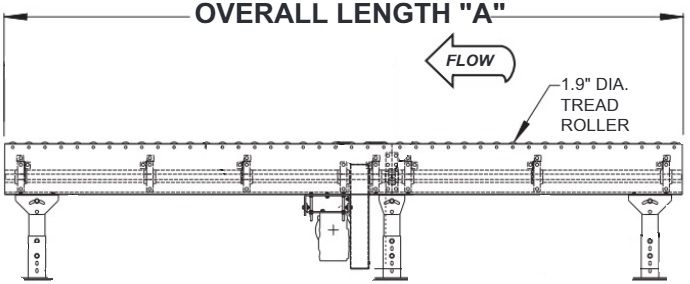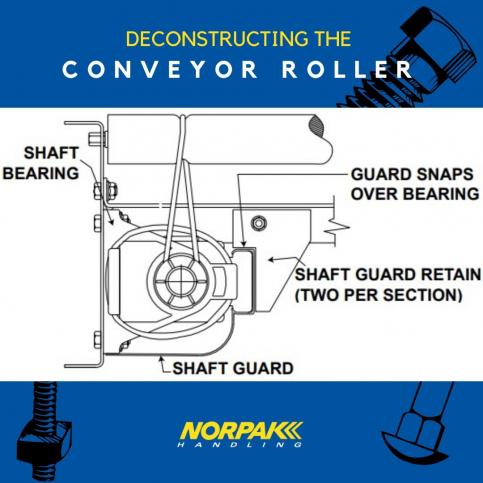Conveyor rollers serve as the undercurrent for a whole host of powered conveyor types to successfully conduct material handing operations.
Let’s lay bare, in general terms, some of the characteristics that make up the essence of said rollers:
Diameter
~1.9” for typical conveying applications, a great example of this is demonstrated by Hytrol’s Model 190-NSP Live Roller Conveyor (Fig. 1.). The conveyance of smaller products are often conducted on 1.4” diameter rollers.

Fig. 1. Side-profile, technical drawing of the Hytrol 190-NSP Live Roller Conveyor; complete with 1.9” dia. conveyor rollers.
Roller Shell Thickness
Round tubing that is fabricated with a wall thickness normally between 16 – 12 gauge.
Material
Fabricated from plain or galvanised steel, as well as being zinc or chrome plated – the choice of which is conditional to your unique handling challenges.
Coatings
Implemented when seeking to drive up the coefficient of friction between the roller and the handled item, or to soften the hard steel surface (usually coated in this case). Coating options include urethane or Teflon sleeves, or dipped or sprayed coating.
Noise
It is not uncommon to be supplied with rollers that come complete with a spring-loaded 0.43” hex shaft; adjustments can be made to reduce the noise a roller may be prone to making within a conveyor frame.
Aside from this, bearings play a similarly vital role in noise production for conveyor rollers – a common by-product of semiprecision bearings. Industry leading suppliers, like Norpak Handling, have taken it upon themselves to partner with top-grade manufacturers that produce more silent bearings with a longer service life – an ideal case for high speed handling situations (e.g. > 1 m/s) but can also be used for slower conveyance should noise be of particular importance.
Curvature/Straightness
While a roller can never be horizontally flush, variance in bend can be adjusted to better serve the handling task at hand, especially for bespoke situations (more on this in the following section). On average, a straightness/total indicator runout (TIR) of 0.045” is employed for a 22” long roller.
Conveyor Rollers For Specialised Material Handling
While these are general, rule of thumb guidelines applicable to most facilities with material handling capabilities, they - by no means - are hard and fast rules for specialised cases. For instance, conveying paper effectively without imparting damage requires special conveyor rollers that deviate from conventional applications. For a situation such as this, here are some of the factors that need to be taken into account:
- Reactivity: paper coatings are notoriously reactive to a variety of surfaces. Stainless steel, as opposed to regular steel, would be a more suitable choice in this instance to wane such a possibility from occurring.
- Wear and Tear: paper, particularly the edges, can be flimsy and susceptible to damage. Conveyor rollers with steep arching between one another magnify the risk of paper bruising and/or tearing as a result of bumping between rollers. Minimising this issue is a call to use straighter than average rollers – for instance, a case could be made for rollers with a TIR of 0.01”.
Heavy Duty Material Handling
Many handling facilities will find themselves tasked with conveying products/pallets that weigh ≥200lbs (e.g. food, engines, drums, crates, etc.) - conveyance of this magnitude would often be considered heavy duty. This can have major implications on the design of a conveyor and their rollers, let’s take the following as an example:
Gravity Roller Conveyor
You’ll come to see that the side frames for gravity roller conveyors for heavy duty product handling are fashioned out of 0.18” – 0.25” formed steel or structural steel channels. With regards to the conveyor rollers, diameter sizing is seen to be ≥2.5”.
Another specification worth mentioning is wall thickness of the conveyor rollers’ shell; that is, the outer surface of the roller that is visible externally. This aforementioned round tubing for heavy duty gravity roller conveyors typically come with a wall thickness ≥11 gauge. Hytrol’s Model 25SR Gravity Roller Conveyor exemplifies these characteristics, manufactured with 2.5” dia. x 11 gauge rollers.
Your Hub For Conveying Excellence
If there’s one take-home message after bringing this all to a close, it’s this: having a thorough understanding of the unique challenges and requirements for your handling project is vital in the communication with your conveyor supplier.
Norpak Handling has a long-standing pedigree (circa 1988) and reputation for consulting, selecting, customising, supplying, and installing conveyors (and bespoke conveyor rollers) successfully through to completion.
Our crew of experts are here to help, whether you’re in the market for that perfect conveyor belt, or trying to find an ideal accumulation conveyor, there is no undertaking that’ll land us out of our depth.
Canada’s certainly a big place, and handling facilities are strewn about from east to west. Wherever you find yourself with conveying woes, Norpak Handling is sure to be close; with offices from Ontario to British Columbia, we’ll always have the inventory of stocked parts, maintenance/service technicians, and design engineers on hand to come on-site and kick-start your operations into optimisation.
Norpak Handling is a leading Canadian conveyor equipment and systems solution provider, specializing in complete project integration services including maintenance and project management.










